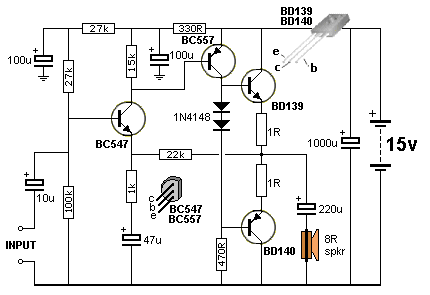boylesg
Advanced Member level 4

- Joined
- Jul 15, 2012
- Messages
- 1,023
- Helped
- 5
- Reputation
- 10
- Reaction score
- 6
- Trophy points
- 1,318
- Location
- Epping, Victoria, Australia
- Activity points
- 11,697

I have implemented this circuit on my bread board, but replaced the 1N4148 + 470R arrangment witha Vbe multiplier, and it seems to work OK with an ipod as audio input.
But I am running it of 12V instead of 15V. Are there any recommended changes for doing this?
The BD139 and BD140 seemed to get quite hot with the diode arrangement but I am able to 'dial' them down a little with my Vbe multiplier so that they dont get quite so hot.
I also made a seperate electret microphone pre-amplifier and AC coupled it to the above and it works really well.
- - - Updated - - -
Is the 470R the collector resistor for BC557?
And what are the 27k and 330r resistors about? I.E. The ones in series with Vcc.
I have a reasonable understanding of the rest of the circuit.
- - - Updated - - -
Perhaps one other thing. What are the two 1r resistors supposed to acheive?

